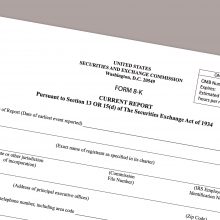What is an 8K and how do you read one?
What is an 8-K?
Form 8-K, also known as an 8K, is a form that is filed by public companies to notify their shareholders and the Securities and Exchange Commission (SEC) when an unscheduled material event takes place. In other words, it’s an announcement that a major event or corporate change that may be of interest to investors, has occurred. Form 8K is known as a “current report” and is filed in addition to an annual report on Form 10-K and a quarterly report on Form 10-Q.
When is Form 8-K Required?
Form 8-K is a mandatory disclosure under the Exchange Act, and must be filed with the SEC within four business days of the occurrence of any material event. However, if the 8K is being filed solely to fulfil obligations under Regulation Fair Disclosure (Regulation FD), it may need to be filed sooner. Material events are any events or releases of information that would be necessary for investors to make informed investment decisions. Here are some examples of when Form 8-K might be required:
- Bankruptcies
- The creation of certain financial obligations, such as incurrence of material debt
- Events that accelerate material obligations (such as defaults on a loan)
- Costs associated with exit or disposal plans (layoffs, plant shutdowns, etc.)
- Changes to fundamental business policies or practices
- Delisting from security exchanges
- Modifications to shareholder rights
- Change in registrant’s certifying accountant
- Elections, appointments, and departures of key executives/principal officers
- Amendments to articles of incorporation or bylaws
- Changes in fiscal period
- Trading suspension under employee benefit plans
- Changes in financials that differ from previously issued financial statements
- Acquisition of or by another company
- Corporate restructuring
- Amendments or waivers of code of ethics
- Changes in shell company status
- Results of shareholder votes
- Certain financial statements and other exhibits
For the full list of situations that require an 8K filing, you can visit the SEC’s investor resource on Form 8-K.
Benefits of Form 8-K
Form 8-K provides timely access to relevant information about public companies that may influence investor decisions. Unlike a press release, social media, or other publication, Form 8-K only lists purely factual information without any explanation of the how or why. This makes it an efficient, unbiased way for investors to get information, and provides a way for public companies to communicate directly with shareholders.
But beyond the benefits to investors, Form 8-K ensures that public companies abide by specific disclosure requirements and can help them avoid any allegations about insider trading. And since they are legally required, they provide reliable data that can help economic researchers understand the effects that specific events have on stock prices.
How to read an 8-K form
An 8-K form only has two parts: the name and description of the material event and any exhibits (resources) that are relevant, such as a financial statement, data table, etc. In order to read an 8K filing, simply go through the form to identify the trigger event and description, along with any of the supporting documents and materials. The contents of 8K filings are straightforward, as they aim to provide facts and context to help investors make informed decisions following the occurrence of a material event. The SEC’s Investor Bulletin on How to Read an 8-K highlights a number of 8-K disclosures that investors may find relevant.
Frequently asked questions about Form 8-K
Where can you find 8K filings?
All 8K filings can be found on the SEC’s Electronic Data Gathering, Analysis, and Retrieval system (EDGAR) database. However, some large companies also post their 8K filings on their websites, usually under the investor relations website.
What is the difference between an 8K and a 10K?
An 8-K is filed by a publicly traded company after an unscheduled material event occurs, whereas a 10-K is an annual report that is filed by a publicly traded company each year.
Who files form 8K?
Public companies are responsible for filing form 8-K with the SEC after the occurrence of a material event.
Is an 8K filing bad?
No. Form 8-K is used to disclose any events or information that may affect investor decisions to the public, so it can contain both positive and negative events. An 8K filing may affect the company’s stock price, but the direction of the price movement will depend on the nature of the trigger event.






























Leave a Reply